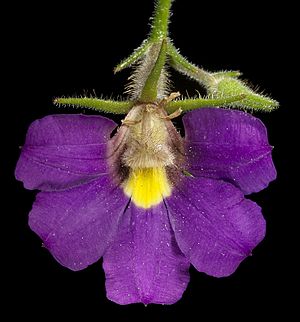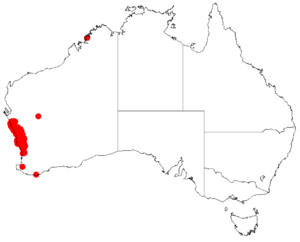Velvet fanflower facts for kids
Quick facts for kids Velvet fanflower |
|
|---|---|
 |
|
| Scientific classification | |
| Genus: |
Scaevola (plant)
|
| Species: |
phlebopetala
|
 |
|
| Occurrence data from Australasian Virtual Herbarium | |
| Synonyms | |
|
Lobelia phlebopetala (F.Muell.) Kuntze |
|
Scaevola phlebopetala, also known as the velvet fanflower, is a small plant that grows close to the ground. It belongs to the Goodeniaceae plant family. You can find it only in Western Australia.
Contents
What Does the Velvet Fanflower Look Like?
The velvet fanflower usually grows flat on the ground. Its stems can reach up to 50 centimeters (about 20 inches) long. These stems are often covered in stiff hairs that stick out straight. This can make them feel a bit rough if you touch them.
Leaves and Flowers
The leaves of this plant do not have stalks. They are usually found directly on the stem. The leaves often have small teeth along their edges. They can be anywhere from 0.5 to 10 centimeters long and 3 to 17 millimeters wide.
The flowers grow in long clusters called racemes. These clusters can be up to 30 centimeters long. Each flower cluster has a curved stem that is about 2 to 4.5 centimeters long. The sepals, which are like small leaves that protect the flower bud, are thin and separate. They measure 4 to 14 millimeters long.
The main part of the flower, called the corolla, is 10 to 27 millimeters long. It has short, white hairs and longer, stiff, yellow hairs on the outside. Inside, it is very hairy. The flowers are a beautiful deep purple color. They have a bright yellow center, which is called the throat.
Fruit and Flowering Time
After the flowers bloom, the plant produces fruit. The fruit is shaped like an egg, but wider at the top. It has lines, bumps, and hairs. Each fruit is about 5 to 6 millimeters long. The velvet fanflower typically blooms from June to October.
Where Does the Velvet Fanflower Grow?
You can find the velvet fanflower in the southwest part of Western Australia. It likes to grow in sandy heaths. Heaths are open areas with sandy soil and low-growing shrubs.
How Was This Plant Named?
The velvet fanflower was first officially named and described in 1860. This was done by a scientist named Ferdinand von Mueller.
Meaning of the Name
The plant's specific name, phlebopetala, comes from two old words. "Phlebos" is a Greek word meaning "vein." "Petalum" is a Latin word meaning "petal." So, phlebopetala means "veined petals." This name describes how the petals of the flower have clear vein patterns.

